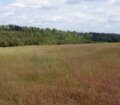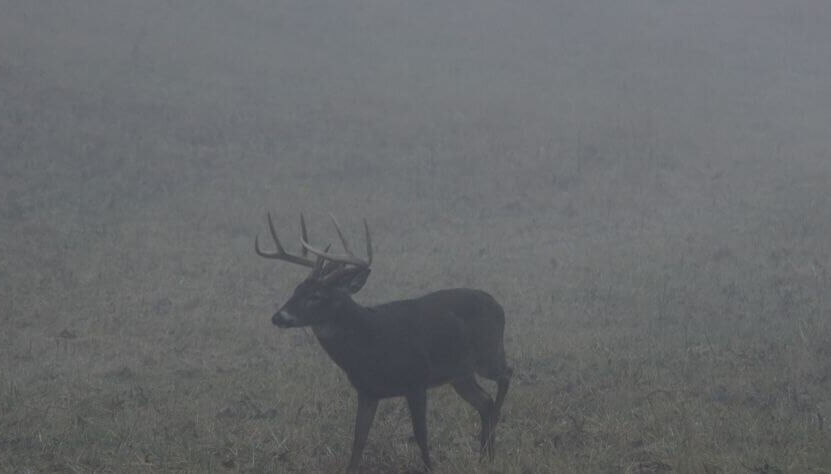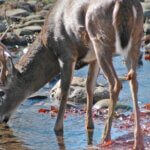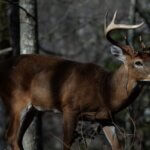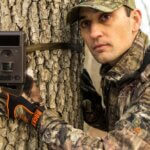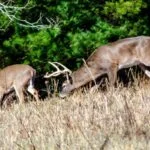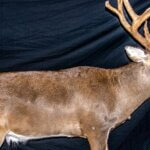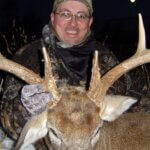Editor’s Note: Deer season starts now. You can improve your chances of taking deer by building stalking trails in pine plantations and using trail/motion sensor cameras. You’ll open-up more land and possibly take bigger bucks on the property you hunt too. Some of the biggest bucks on the land you hunt may live in 2- to 15-year-old pine plantations where the bucks can survive for many years and only come out of the pines when they experience no hunting pressure. Mark Thomas, a wildlife biologist and forester, manages many properties for deer using trail cameras.

Question: Most outdoorsmen think of using motion-sensor cameras primarily to survey deer herds and to locate and take big bucks. Can you also use your cameras to survey all the wildlife on the property?
Thomas: Yes, one time when I censused 2800 acres, I put 56 cameras on that land and used a variety of different types of baits, including fox, raccoon, coyote and deer scents as well as corn, sardines, tuna and cat food, to census the wildlife on the property. Then I put some of the cameras on game trails to survey the wildlife.
Question: Why were you using various types of scents?
Thomas: I used the scents to attract different types of wildlife. For instance on the census I mentioned, I photographed bobcats, feral cats, coyotes and predators using predator scents. Many times when you’re censusing coyotes, you’ll get a picture of a coyote urinating on your scent pole, because he’s trying to mark his territory.
Question: Why is knowing what predators and their approximate numbers you have on the land important?
Thomas: If you have a large number of predators on your land, they’ll often cause a reduction in the game species you’re trying to manage. For instance, one property on the Alabama-Mississippi line that I was involved with had a noticeable decline in its turkey population for 3-5 years. I was called in to do a census of that property. What I learned from my photo-census using motion-sensor cameras was that the property had unusually-high bobcat and coyote populations.
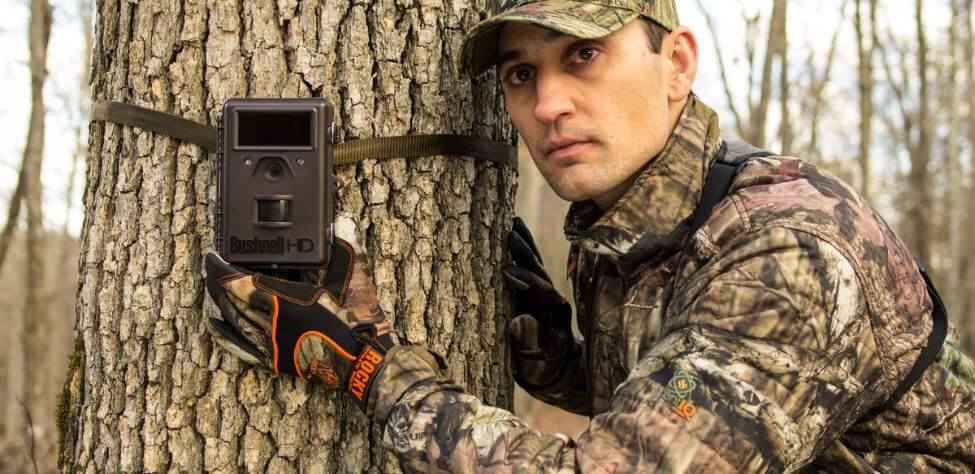
Once we determined that there were a large number of predators, we instituted a trapping program for 3 years on that property that produced 47 adult bobcats. Forty-six of those bobcats were males. The male bobcats were running up and down the river system. Once we reduced the predator population to a more-normal level, the turkey population rebounded and became more numerous on the property. So, by using cameras to census your entire wildlife population, you can get a better handle on what may need to be done to better manage a specific species.
In some areas, we’ve discovered feral dogs by using cameras. Feral dogs often will pack-up on a property. Once they pack-up, they’ll revert back to their more-primitive instincts and have a more coyote or a wolf mentality. These packs of wild dogs will kill fawns, adult deer, rabbits and any other type of critter they can catch. Many times they won’t even consume the animals they kill. So, you don’t want packs of wild dogs on your lands. With a camera census, you can determine not only your predator-population numbers but also the kinds of predators on your property.
Question: How do you set-up your cameras to photograph predators?
Thomas: I like to set my cameras high and aim them down toward the bait stations. This way you get a better view of the overall size and condition of the animal. By photographing down on the animal, you get a more three-dimensional photograph of the subject. Photographing on the same level as the subject produces a more two-dimensional photograph. I also set my cameras high for deer, so when the camera takes a picture, I can better see the deer’s rack. I also can better determine the number of points in the antler mass. Another advantage of setting the camera high is that the scent of the camera is above the nose of the predators and the deer. Always when you’re photographing predators and deer, wear rubber boots to and from the camera locations.

Question: What type of bait are you using for predators?
Thomas: I use scents more than lures when I’m surveying predators.
Question: Predators aren’t just bound to the ground; they also strike from the air. Avian predators like hawks and owls can cause many problems with turkey and quail populations. What are you doing to keep the avians away from game species on the lands you manage?
Thomas: You can use your cameras and bait stations to photograph avians. However, hawks and owls migrate rather than stay on one piece of property. To solve an avian problem, I suggest you develop canopy plants on your land. The canopy plants need to be from 3- to 5-feet tall to shield quail and turkey poults from avian attacks. Use poke, ragweed, milkweed and plants with a broad shape and form where turkey poults and quail can hide to protect them from aerial predators.

How to Hunt and Take Big Buck Deer on Small Properties
In this book, you’ll hear from 14 hunters who either have gained permission or leased properties as small as six acres to as much as 250 acres, and how they consistently take older-age-class bucks off these little lands.
VERSIONS: AUDIBLE, KINDLE & PRINT

Jim Crumley’s Secrets of Bowhunting Deer
Using a black magic marker and a gray work jumpsuit, Jim Crumley of Buchanan, Virginia, drastically changed the nature and purpose of hunting camouflage when he created the first sportsman’s camouflage – Trebark. Crumley’s love of bowhunting and his desire to be more invisible changed hunting clothing forever.
In this hunting guide, he shares the wisdom that he’s learned throughout his lifetime about how to be a hunter, how to find a deer lease, how to scout for deer, and more.
Special features include how to:
- Have a magic 60 acres to hunt
- Decide the best equipment to use
- Find deer year-round
- Locate land to hunt
- Know the best place to put your tree stand
- Get bucks within bow range
VERSIONS: AUDIBLE, KINDLE & PRINT

How to Hunt Deer Like a Pro
How do you know if the land you hunt has a trophy deer on it? Wildlife manager Bob Zaiglin, of Uvalde, Texas and Jim Crumley, the father of modern-day hunting camouflage, tells you how to find out. GPS can make finding and taking that trophy buck easier. This hunting guide will teach you how to hunt big bucks where no one else can find them, how to call deer, and how to become versatile as a deer hunter, so that if one deer tactic doesn’t work, another one will.
In the chapter, “How to find Bucks at Scrape,” Dr. Keith Causey, retired professor of Wildlife Science at Auburn University, describes the best way to hunt a scrape.
Brad Harrison of Neosho, Missouri, is a nationally-known videographer, professional deer hunter and master at calling deer. Another master is Will Primos of Primos Game Calls. These two experts will tell the best deer calls and when to use them in this book.
And for over 20 years, Bo Pitman, lodge manager of White Oak Plantation, has been studying deer movement patterns. He explains what types of conditions are best for predicting deer movement.
VERSIONS: AUDIBLE, KINDLE & PRINT

Deer hunting and deer hunters are drastically changing each year. To learn new techniques for hunting deer and have more places to hunt, I’ve interviewed some of the best deer hunters in the nation and share their tactics in How to Hunt Deer Like a Pro: Volume II.
In Chapter 10, Jacob Lamar tells you his tactics for consistently taking older-age-class bucks on public lands in several states. Chapter 11, Bob Walker explains how to find places on public lands where you can hunt that 99 percent of the other hunters never have considered hunting. The Bonus Chapter with David Ramey tells you how, where, when and with what equipment to take big Kansas bucks on public lands by hunting in 100-degree weather when others won’t hunt.
Chapter 13, Mark Drury, his family and his guests take mature bucks every season by having more small places to hunt rather than one large property. Drury explains the strategy of having satellite farms to hunt that only may be 50-150 acres each or less. Chapter 15, Pat Reeve, who hunts far-northern states and Canada, says, “I don’t like hunting for mature bucks until the weather is 20 degrees or less.” Chapter 4, Dr. Larry Marchinton says that funnels are the most-reliable stand sites to hunt for big bucks and tells why.
VERSIONS: AUDIBLE & PRINT


